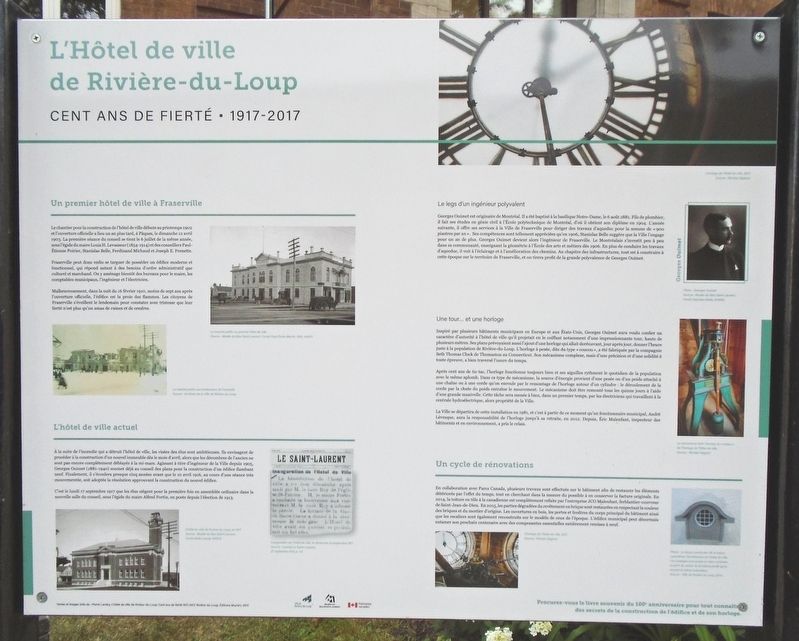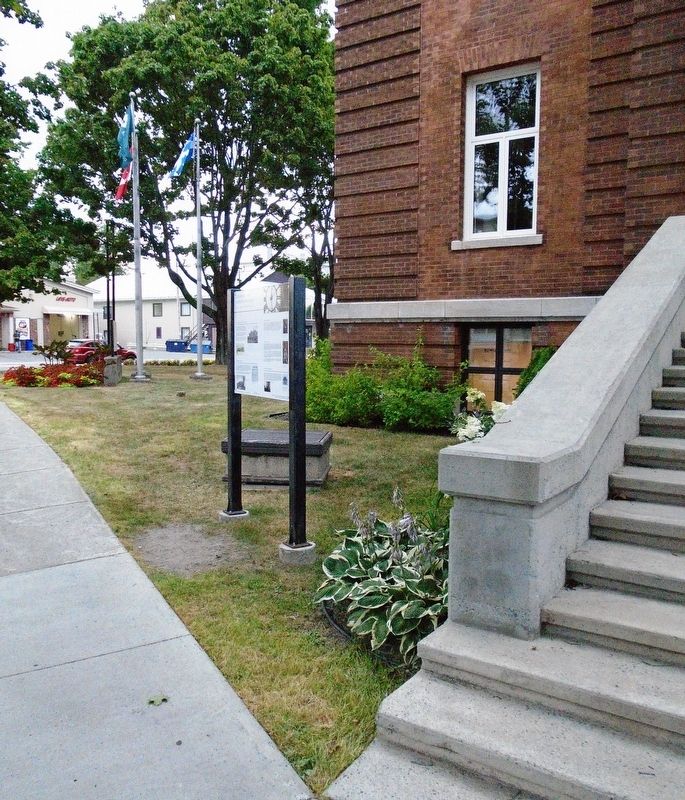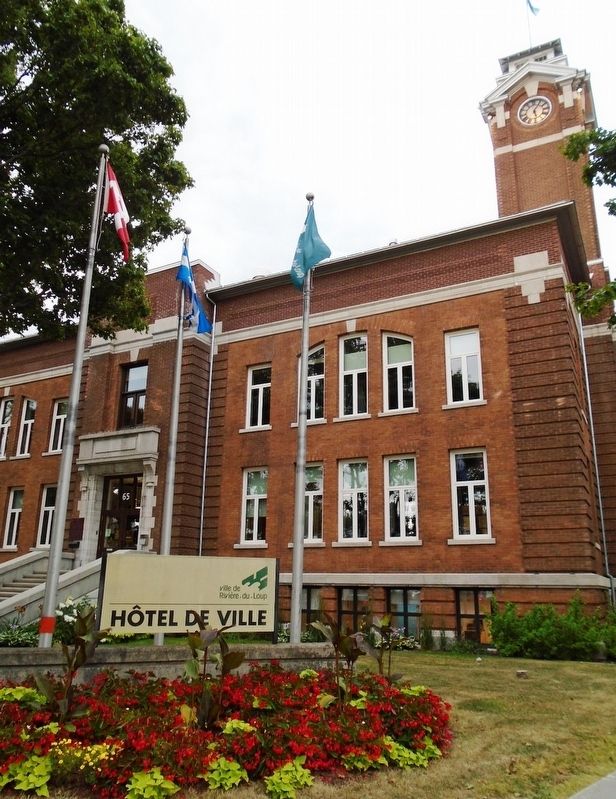L'Hôtel de ville de Rivière-du-Loup
Cent ans de fierté • 1917-2017
Un premier hôtel de ville à Fraserville
Le chantier pour la construction de l'hôtel de ville débute au printemps 1902 et l'ouverture officielle a lieu un an plus tard, à Pâques, le dimanche 12 avril 1903. La première séance du conseil se tient le 6 juillet de la même année, sous l'égide du maire Louis H. Levasseur (1854-1914) et des conseillers Paul-Étienne Poirier, Stanislas Belle, Ferdinand Michaud et Joseph E. Frenette.
Fraserville peut donc enfin se targuer de posséder un édifice moderne et fonctionnel, qui répond autant à des besoins d'ordre administratif que culturel et marchand. On y aménage bientôt des bureaux pour le maire, les comptables municipaux, l'ingénieur et l'électricien.
Malheureusement, dans la nuit du 16 février 1910, moins de sept ans après l'ouverture officielle, l'édifice est la proie des flammes. Les citoyens de Fraserville s'éveillent le lendemain pour constater avec tristesse que leur fierté n'est plus qu'un amas de ruines et de cendres.
[Légendes des photos, de haut en bas, lisez]
• Le marché public ou premier hôtel de ville.
• Le marché public aux lendermains de
l'incendie.L'hôtel de ville actuel
À la suite de l'incendie qui a détruit l'hôtel de ville, les visées des élus sont ambitieuses. Ils envisagent de procéder à la construction d'un nouvel immeuble dès le mois d'avril, alors que les décombres de l'ancien ne sont pas encore complètement déblayés à la mi-mars. Agissant à titre d'ingénieur de la Ville depuis 1905, Georges Ouimet (1881-1940) soumet déjà au conseil des plans pour la construction d'un édifice flambant neuf. Finalement, il s'écoulera presque cinq années avant que le 10 avril 1916, au cours d'une séance très mouvementée, soit adoptée la résolution approuvant la construction du nouvel édifice.
C'est le lundi 17 septembre 1917 que les élus siègent pour la première fois en assemblée ordinaire dans la nouvelle salle du conseil, sous l'égide du maire Alfred Fortin, en poste depuis l'élection de 1913.
[Légendes photo, de gauche à droite, lues]
• L'hôtel de ville de Rivière-du-Loup, en 1917.
• Inauguration de l'hôtel de ville, le dimanche 23 septembre 1917.
[La légende de la photo en haut à droite indique]
L'horloge de l'hôtel de ville, 2017.
Le legs d'un ingénieur polyvalent
Georges Ouimet est originaire de Montréal. Il a été baptisé à la basilique Notre-Dame, le 6 août 1881. Fils de plombier, it fait ses études en génie civil à l'École polytechnique de Montréal, d'où
[La légende de la photo se lit] Georges Ouimet
Une tour... et une horloge
Inspiré par plusieurs bâtiments municipaux en Europe et aux États-Unis, Georges Ouimet aura voulu confier un caractère d'autorité à l'hôtel de ville qu'il projetait en le coiffant notamment d'une impressionnante tour, haute de plusieurs mètres. Ses plan prévoyaient aussi l'ajout d'une horloge qui allait dorénavant, jour après jour, donner l'heure juste à la population de Rivière-du-Loup. L'horloge à pesée, dite du type « coucou », a été fabriquée par la compagnie Seth Thomas Clock de Thomaston au Connecticut. Son mécanisme complexe, mais d'une précision et d'une solidité
à toute épreuve, a bien traversé l'usure du temps.Après cent ans de tic-tac, l'horloge fonctionne toujours bien et ses aiguilles rythment le quotidien de la population avec le même aplomb. Dans ce type de mécanisme, la source d'énergie provient d'une pesée ou d'un poids attaché à une chaîne ou à une corde qu'on enroule par le remontage de l'horloge autour d'un cylindre : le déroulement de la corde par la chute du poids entraîne le mouvement. Le mécanisme doit être remonté tous les quinze jours à l'aide d'une grande manivelle. Cette tâche sera menée à bien, dans un premier temps, par les électriciens qui travaillent à la centrale hydroélectrique, alors propriété de la Ville.
La Ville se départira de cette installation en 1981, et c'est à partir de ce moment qu'un fonctionnaire municipal, André Lévesque, aura la responsabilité de l'horloge jusqua'à sa retraite, en 2012. Depuis, Éric Malenfant, inspecteur des bâtiments et en environnement, a pris le relais.
[La légende de la photo se lit]
Le mécanisme Seth Thomas, le « moteur » de l'horloge de l'hôtel de ville.
Un cycle de rénovations
En collaboration avec Parcs Canada, plusieurs travaux sont effectués sur le bâtiment afin de restaurer les éléments détériorés par l'effet du temps, tout en cherchant dans la mesure du possible à en conserver la facture originale. En 2014, la toiture en tôle à la canadienne
est complètement refaite par l'entreprise JCO Malenfant, ferblantier-couvreur de Saint-Jean-de-Dieu. En 2015, les parties dégradées du revêtement en brique sont restaurées en respectant la couleur des briques et du mortier d'origine. Les ouvertures en bois, les portes et fenêtres du corps principal du bâtiment ainsi que les escaliers sont également reconstruits sur le modèle de ceux de l'époque. L'édifice municipal peut désormais entamer son prochain centenaire avec des composantes essentielles entièrement remises à neuf.
[Légendes photo, de gauche à droite, lisez]
• L'horloge de l'hôtel de ville, 2017.
• Le dessin particulier de la volture caractérise l'architecture de l'hôtel de ville. Les losanges sont posée en sens contraire à partir du centre de la toiture plutôt qu'en suivant la même orientation.
Procurez-vous le livre souvenir du 100e anniversaire pour tout connaître des secrets de la construction de l'édifice et de son horloge.
Fraserville's first city hall
The building site for the construction of the Town Hall began in the spring of 1902 and the official opening took place a year later, at Easter, on Sunday, April 12, 1903. The first meeting of the council was held on July 6 of the same year, under the aegis of Mayor Louis H. Levasseur (1854-1914) and Councilors Paul-Etienne Poirier, Stanislas Belle, Ferdinand Michaud and Joseph E. Frenette.
Fraserville could finally boast of having a modern and functional building that met administrative, cultural and commercial needs. Offices were soon set up for the mayor, the municipal accountants, the engineer and the electrician.
Unfortunately, in the night of February 16, 1910, less than seven years after its official opening, the building fell prey to flames. The citizens of Fraserville woke up the next day to note with sadness that their pride was nothing more than a pile of ashes and ruins.
[Photo captions, from top to bottom, read]
• The public market in the fire's aftermath.
The current city hall
Following the fire that destroyed the city hall, the aims of elected officials were ambitious. They planned to proceed with the construction of a new building in April, while the rubble of the old is not yet completely cleared in mid-March. Acting as an engineer for the city since 1905, Georges Ouimet (1881-1940) had already submitted to the council plans for the construction of a brand new building. Finally, it would take almost five years until April 10, 1916, when in a very hectic session, the resolution approving the construction of the new building was adopted.
It was Monday, September 17, 1917, that elected representatives sat for the first time in an ordinary meeting in the new council chamber, under the direction of Mayor Alfred Fortin, who was in office since the election of 1913.
[Photo captions, from left to right, read]
• Inauguration of City Hall, Sunday, September 23, 1917.
[Photo caption at the top right of marker reads]
The legacy of a versatile engineer
Georges Ouimet was from Montreal. He was baptized at Notre-Dame Basilica on August 6, 1881. Son of a plumber, he studied civil engineering at the École polytechnique de Montréal, where he graduated in 1904. The following year, he offered his services to the Town of Fraserville to direct the Water Works for the sum of "900 dollars a year." His skills were so appreciated that in 1906, Stanislas Belle suggested that the City commit for one more year. Georges Ouimet became the Fraserville engineer. The Montrealer gradually invested in his community, teaching geometry at the School of Arts and Crafts beginning in 1906. In addition to conducting aqueduct work, he oversaw town lighting and road improvement. In terms of Fraserville area infrastructure, everything was being built at that time, and the town took advantage of Georges Ouimet's great versatility.
[Photo caption reads] Georges Ouimet
A tower ... and a clock
Inspired by several municipal buildings in Europe and the United States, Georges Ouimet wanted to entrust a character of authority to the town hall with styling that including an impressive tower many meters high. His plan also included the addition of a clock that would, day after day, give the correct time to the people of Rivière-du-Loup. The clock was manufactured by Seth Thomas Clock Company in Thomaston, Connecticut. Its complex mechanism, with its precision and solidity, has been well tested over time.
After 100 years of ticking, the clock still works well and its hands punctuate daily public life with the same assurance. In this type of mechanism, the source of energy comes from a weight attached to a chain or rope that is wound around a cylinder: gravity unwinds the rope as the weight falls, causing the clock's movement. The cylinder mechanism must be rewound every fortnight using a large crank. This task was initially carried out by the electricians who worked at the hydroelectric power station, then property of the City.
The City disposed of this facility in 1981, and it was from then on that a municipal official, André Lévesque, was responsible for the clock until his retirement in 2012. Since then, Éric Malenfant, buildings and environmental inspector, took over.
[Photo caption reads]
A cycle of renovations
In collaboration with Parks Canada, several works are being carried out on the building in order to restore elements deteriorated by the effects of time, while seeking as far as possible to keep the original intact. In 2014, the sheet metal roof in the Canadian style was completely redone by the company JCO Malenfant, tinsmith-roofer of Saint-Jean-de-Dieu. In 2015, the degraded parts of the brick cladding were restored, respecting the original brick and mortar colors. The wooden parts, the doors and windows of the main building, as well as the stairs were reconstructed to match the original style. The municipal building begins its next century with essential components completely refurbished.
[Photo captions, from left to right, read]
• The particular volture design characterizes town hall architecture. The diamonds are placed in the opposite direction from the center of the roof rather than following the same orientation.
Get the 100th Anniversary Memory Book to learn all the secrets of building construction and the clock.
• The public market or first city hall.
• Rivière-du-Loup Town Hall, in 1917.
The City Hall clock, 2017.
The Seth Thomas mechanism, the "engine" of the City Hall clock.
• The Town Hall clock, 2017.
Erected 2017 by Ville de Rivière-du-Loup and others.
Topics. This historical marker is listed in this topic list: Notable Buildings. A significant historical year for this entry is 1902.
Location. 47° 50.139′ N, 69° 32.214′ W. Marker is in Rivière-du-Loup, Québec. Marker is on rue Lafontaine (Québec Route 185) just south of rue de l'Hôtel de Ville, on the right when traveling north. Touch for map. Marker is at or near this postal address: 64 rue de l'Hôtel de Ville, Rivière-du-Loup QC G5R 3Y7, Canada. Touch for directions.
Other nearby markers. At least 8 other markers are within 26 kilometers of this marker, measured as the crow flies. Le projet Fraserville / The Fraserville Project (within shouting distance of this marker); Hôtel de Ville / City Hall (within shouting distance of this marker); Hôtel-de-Ville-de-Rivière-du-Loup / Rivière-du-Loup Town Hall (within shouting distance of this marker); John McLoughlin (within shouting distance of this marker); CJFP (within shouting distance of this marker); L'Église de Saint-André / The Church of Saint-André (approx. 23.1 kilometers away); L'Église / The Church (approx. 24.8 kilometers away); Le couvent du Saint-Rosaire / The Saint-Rosaire Convent (approx. 24.9 kilometers away). Touch for a list and map of all markers in Rivière-du-Loup.
Also see . . . Ville de Rivière-du-Loup. City website homepage (Submitted on November 1, 2018, by William Fischer, Jr. of Scranton, Pennsylvania.)
Credits. This page was last revised on January 7, 2022. It was originally submitted on November 1, 2018, by William Fischer, Jr. of Scranton, Pennsylvania. This page has been viewed 190 times since then and 14 times this year. Photos: 1, 2. submitted on November 3, 2018, by William Fischer, Jr. of Scranton, Pennsylvania. 3. submitted on November 1, 2018, by William Fischer, Jr. of Scranton, Pennsylvania.


